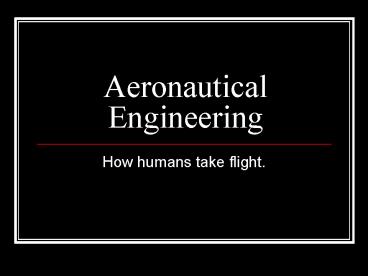Aeronautical Engineering - PowerPoint PPT Presentation
1 / 16
Title: Aeronautical Engineering
1
Aeronautical Engineering
- How humans take flight.
2
Unit Timeline
- Week 1
- 1 day
- Historic Development
- Different aviation attempts
- 3 days Anatomy of a plane
- Plane Parts
- Design Variations
3
Unit Timeline
- Week 2 Why Planes Fly.
- 4 days
- Conservation of Momentum
- Drag and Lift force
- Aerodynamic Analysis
- Continuity Equation
- Bernoulli Equation
- Wing shape
4
Week 3
- 2- days
- Flight paths
- Fuel efficient flight paths
- Step Climb
- Rocket Trajectories
- 2 - days
- Stability and control
- Structure
5
Week 4
- Control
- Pitch, Yaw,Roll
- Flight Simulator
- Propulsion
- Propellers
- Jet
- Turbojet
6
Flying - Bird vs. Man
- Physical differences (incomplete list)
- Sparrows heart 800bpm
- Pigeon 400 breaths per min
- Bone density
- The point is, men are not physically designed for
flight or flight propulsion.
7
Types of Aircraft
- Lighter than Air
- Hot Air Balloon
- Blimp
- Zeppelin
- Heavier than Air
- Planes
- Gliders
8
Lighter than Air
- Hot Air
- French Montgolfier brothers
- First manned flight
- Hydrogen
- Pilatre (1785) combined the concepts to an
explosive result
9
Lighter than Air
- Zeppelin
- 1900 Rigid Air Ship
- Initiated Air Travel
- Scheduled flights from Germany to South America
10
Pros vs. Cons
- Lighter than air is 2-3x more expensive per cargo
ton than airplanes which are 6x faster.
11
Heavier than Air
- Cayley (1773-1857)
- First to build air tunnels and test ideas
- Built a glider sending a 10yr old boy several
meters high - No Powered flight (power to weight problem)
- Sent others on his test flights
- Otto Lilienthal (1848-1896)
- Aerodynamic data for wings which the Wright
brothers used and revised. - Flew his own creations, died in a glider accident
12
Development of Powered Flight
- Wright Brothers
- First flight in 1901, glider range of 600ft.
- Chose Kitty Hawk due to favorable conditions
- Wind, hills, soft ground
- 1902 solved control issues now needed propulsion.
13
Kitty Hawk 1903
- Built their own engine 12hp weighing less than
200lbs. - Developed propeller efficiency estimates
- Dec 17th 4 flights 852ft. Into 24mph winds
- Equivalent distance of over 1/2 mile
- Gust of wind knocked it over and it never flew
again. - Europe wanted it for military purposes
- US Army didnt get want one until 1909.
14
WW1
- Huge boom in planes
- Served military purpose
- Reconnaissance
- Fighters (armed with a pistol at first)
- Bomber
Bristol Fighter F-2B Engine275 hp Rolls-Royce
Falcon Maximum Speed123 mph (198 kph) Maximum
Height21,500 ft (6,533 m) Endurance 3
hours Armament3 machine-guns, 260 lb (108.9 kg)
bomb load
15
1920-1940
- Continued boom as militaries created air forces
- 1927 Lindbergh flew from NY to Paris, navigation
- compass, judgment and luck.
16
Passenger Aircraft
- 1933 - Boeing 247
- 10 passengers 155mph
- Sold all to United
- TWA Responds with DC-2 then DC-3 most successful
plane ever. - 11,000 built
- Used through WW2 and even into the late 80s
- Developments from fighter planes find their way
into passenger planes
DC-3 Rose pictured in an air show from 2001.

